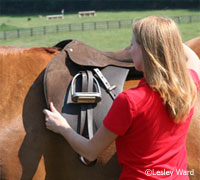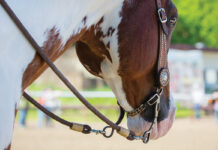 One of the most important things you can do for your horse is to make sure his tack fits properly. Poor fitting tack is comparable to you wearing poorly fitted shoes: too tight and you’ve got squished toes and painful feet; too loose and blisters abound. A horse suffers the same fate when a small saddle pinches his withers or a big saddle rolls around on his back. And, an ill-fitting bridle won’t allow the bit to sit correctly in your horse’s mouth, causing discomfort and training problems.
One of the most important things you can do for your horse is to make sure his tack fits properly. Poor fitting tack is comparable to you wearing poorly fitted shoes: too tight and you’ve got squished toes and painful feet; too loose and blisters abound. A horse suffers the same fate when a small saddle pinches his withers or a big saddle rolls around on his back. And, an ill-fitting bridle won’t allow the bit to sit correctly in your horse’s mouth, causing discomfort and training problems.
English Saddles
Saddler: Mike McCloy
Company: La Jolla Saddle Company, Julian, California
Learned his craft: The famous saddle town of Suffolk, England, and with Dutch master saddler Theo Jonas.
Step One: Measure and Choose a Size
The best way to find the proper size is to purchase a tool called a “Flexi-Curve” (an inexpensive flexible drafter’s tool sold in art supply shops) that you will use to trace your horse’s withers. Follow these steps:
1. Stretch the Flexi-Curve over your horse’s withers, start with the center of the curve across the withers and down two fingers behind the point of the shoulder.
2. Set the Flexi-Curve down on a large sheet of sturdy cardboard and trace the inside shape.
3. Cut out the shape and take it with you to the tack store. Set this template inside the pommel of the saddle (pretend the cutout is your horse’s shoulders and withers) to find a close fit. If you’re purchasing a saddle through the mail, send the template in with your order. The cutout should not fit perfectly inside the pommel like a puzzle piece. You should be able to fit two to four fingers between your cutout and the pommel. The bottom half (the shoulders) should fit well inside the panel (the stuffed part that follows the contours of the horse’s back).
English saddles generally come in tree sizes of 30, 31, 32, et cetera (denoting the width of the tree in centimeters from point to point), or narrow, medium and wide.
- An average Thoroughbred will wear a medium or 31.
- A Saddlebred will generally wear a narrow or 30.
- A warmblood will wear a wide or 32.
Keep in mind that this is a generalization. These sizes are to give you an idea of what size may fit your horse.
Step Two: Try it Out
- Stand your horse squarely on a level area.
- Place the saddle on his back without a pad or girth.
- Without using a saddle pad, place the saddle far forward and slide it back into position to rest just behind the shoulder muscle, not on the shoulder blade.
- Check for proper contact. Put your hand on the top of the saddle and apply slight pressure. You won’t be using a girth so you’ll need to hold the saddle down with your hand. Slide your other hand underneath the sweat flap next to your horse’s back. Push with your fingers along the panel to see if your fingers can slide underneath the panel at any point. If they can, the saddle is not making good contact with your horse’s back.
Step Three: Find the Pommel Clearance
- For significant withers, place four stacked fingers under the pommel for proper clearance; withers that require less clearance require two stacked fingers clearance. The clearance will shrink after the saddle breaks in.
- If you can fit more than four fingers under a new saddle, it’s too narrow; less than two and it’s too wide.
Step Four: Proper Balance
- Check to see if the flat area of the seat is parallel to the ground. The tip of the cantle should be slightly above the pommel (the cantle will vary in height due to saddle style).
- Make sure the pommel is not higher than the cantle. Your balance will be off if the saddle pushes you behind the horse’s center of gravity. If the lowest part is toward the cantle, it is too narrow and will pinch your horse. If the lowest point is toward the pommel, the tree is too wide and will press down painfully against his withers.
- The gullet should span the horse’s spine, not rest on it. You should be able to look all the way down the length of your horse’s back.
Step Five: Add a Pad
When checking saddle fit, be careful not to use a pad that is too thick, as it will skew your results. A thin, quilted pad is your best bet for a properly fitted saddle unless your horse requires a therapeutic pad.
Step Six: Test Ride
Girth up and check your fit by placing your hand flat behind your seat (fold your thumb under). You should have only four fingers space from your seat to the cantle.
TIP Tack shops and catalogs offer trial saddle periods. Never purchase a saddle without trying it on your horse first. Remember to give the saddle extra care. Saddles returned scratched or worn won’t be accepted. Remember to ask the company about their policy regarding how to attach stirrups and girths for trial.
Western Saddles
Saddler: Larry Springfield
Company: Big Horn Saddles
Learned his craft: 30 years experience with horses)
Step One: Finding the Fit
All types of western saddles are fitted similarly. There are three standard bar widths in western saddle trees:
- Quarter Horse bar—fits 80 percent of all western horses.
- Semi-Quarter Horse bar—fits higher-withered horses.
- Full Quarter Horse bar—fits flat or “mutton-withered” horses.
The western tree is made up of the cantle, the bars and the swells. The bars run along the horse’s back and denote the shape of the saddle and the width of the gullet.
Step Two: Try it Out
- Place the saddle on the horse with it cinched, but without the pad, and then with the pad.
- Check that you are able to get two to three fingers clearance between the withers and the top of the gullet.
Step Three: Add a Light Pad
Make sure that the skirting, the rounded leather panels under the tree, follows the contours of the horse’s back. You want the bars of the saddle to make contact with the horse’s back. If you see space under the back of the saddle, or the skirt is lifting up, it’s not fitting properly.
Step Four: Sweat Patterns
Check the pattern of your horse’s sweat marks after you take the saddle off. If you see dry spots, the saddle is possibly “bridging” or not fitting properly. You can also try a different pad to improve the fit.
![]() A word about “sweat patterns…” Don’t rely on sweat patterns to find your English saddle fit. Sweat patterns can be erratic with a new saddle or a newly flocked saddle. The flocking or stuffing needs a chance to break into the shape of your horse’s back. If after two weeks the sweat patterns are still uneven, contact the company or have the saddler look at the saddle again. Sweat patterns are useful for western saddles because they do not have stuffed panels.
A word about “sweat patterns…” Don’t rely on sweat patterns to find your English saddle fit. Sweat patterns can be erratic with a new saddle or a newly flocked saddle. The flocking or stuffing needs a chance to break into the shape of your horse’s back. If after two weeks the sweat patterns are still uneven, contact the company or have the saddler look at the saddle again. Sweat patterns are useful for western saddles because they do not have stuffed panels.
Step Five: Mount Up
You should comfortably settle into the deepest part of the seat and not feel jammed in. The most popular size for western saddles is a 15- or 16-inch seat. You should have adequate clearance for your legs and your stomach.
Bridles
First, determine the fit. Again, these sizes are generalizations. Each properly fitted bridle should leave you enough leather to adjust up or down one hole.
English
- Pony: several sizes are available.
- Cob: Arabians or horses with petite heads.
- Horse: an average size intended for the typical Thoroughbred and Quarter Horse.
- Warmblood: large horses, draft crosses. Western
- Arabian or Pony
- Standard: -average size intended for Paints and Quarter Horses
- Extra Large: large-headed cross-breeds, draft crosses.
Bits
Size is determined by inches, and the average size worn is 5, but the best way to find out your horse’s size is to measure with a bit of string. Tie a pencil to a fat string. Slide the free end of the string through your horse’s mouth to the other side and make a knot on the end. The pencil should rest at one corner of your horse’s mouth and the knot at the other. Remove the string and measure with a ruler, rounding up to the nearest quarter inch. Figure in one size up if you’re choosing a loose-ring snaffle. The rings on too small of a bit can pinch if they don’t clear the edges of your horse’s lips. Follow these steps to determine the proper fit of your horse’s bit:
English Snaffle
- The bit hinges should clear the corners of the horse’s lips. Move the hinges around to make sure they don’t pinch.
- Adjust the cheek pieces so that the bit wrinkles the corners of your horse’s mouth in one or two folds.
- The standard noseband should fit two fingers below the cheekbones. You should have enough leather to be able to tighten the noseband so that only one finger fits under it.
- The top of a flash noseband should also fit two fingers below the cheekbones. You should be able to adjust the bottom half of the noseband quite tightly below the rings of the snaffle.
- Four fingers sideways should fit inside the throatlatch.
Western Snaffle
- Adjust the cheekpieces so that the bit wrinkles the corners of the mouth in one small fold.
- Attach a leather or nylon curb strap below the reins. Make it loose enough so that it hangs down against the chin, but not so loose so that your horse can get it into his mouth. (Western trainers use the curb strap to help keep the bit from sliding through a horse’s mouth while teaching the basics of turning.)
Western Curb
- Adjust the cheekpieces so that the bit wrinkles the corners of the mouth in one or two folds.
- Attach a curb strap (can include a chain). You should be able to fit two fingers stacked between the chin and the strap when the reins are loose.
Tack Care
Have your English saddle looked at once a year by a saddler or trainer to note any problems. A well-fitting western saddle is virtually maintenance free. Clean all styles of tack with a good leather cleaner preferably every time you ride. At the very least, wipe the dust away with a soft cloth. Dust and sweat can cause the leather to become slippery. Don’t oil your English tack frequently—once or twice a year is a good rule of thumb. Today’s English saddles are built for comfort with softer, thinner leathers. Oil causes the fibers of the leather to separate and pressure will break down the leather. Some manufacturers will tell you to never oil their tack. Western saddles, due to their heartier nature, can be oiled more frequently. But remember that oiling a light saddle may cause it to darken considerably. Brush suede seats off with a light brush and brush the fleece underneath the saddle.
![]() A wide-sized saddle from one English saddler may not be the same “wide” of another brand: Tree flap widths and flocking (stuffing) vary. The same goes for western; one saddler’s idea of a standard Quarter Horse bar may differ from another’s. It’s better to have a saddle that is too wide than too tight. One thick pad can make up one size. A saddler can also help by re-stuffing an English saddle.
A wide-sized saddle from one English saddler may not be the same “wide” of another brand: Tree flap widths and flocking (stuffing) vary. The same goes for western; one saddler’s idea of a standard Quarter Horse bar may differ from another’s. It’s better to have a saddle that is too wide than too tight. One thick pad can make up one size. A saddler can also help by re-stuffing an English saddle.
Read on for more on saddle fit.






Great article, I appreciate the info!
Overall, I thought it was very good. However, I did have an issue with the bit adjustment advice. A properly fitted bit has nothing to do with wrinkles in the corners of the mouth. A bit that is properly adjusted should hang halfway between a horses’ molars, and his front teeth. On some horses, this means 3 wrinkles, on others, none.
Well it helped me a little. If it had pictures or diagrams it would be more helpful. Its alot of info to cram into a small segment. More indepth would be nice. I have 4 horses and each one is extremely different for saddle fit. 1 takes semi( high withered arab/quarter) 1 takes full quarter( mutton withered paint) 1 takes full quarter with high qullet(high withered quarter) and alas my new horse that I’m trying to fit(broad withered hanoverian/paint)good luck to me lol.
good article!
It is important all tack fits not just saddles
IT WAS WELL DONE I THINK IT WILL BE REALLY GOOD FOR MY 4H CLUB.
Awesome article, looking up stuff for my PATH INTERNATIONAL certification and this site helped me, THANKS!
Thanks for the good advise. So many times we buy a saddle without true reguard to fit of our horses. when we take their well being and put it frist we are really looking out for our own. Thank you for the article, It made me remeber theres alot more than seat size and my confort to consider.
Wow, what an extensive article. Thanks!
This was a great and informative article so thanks for sharing! Horses are amazing animals and I love them! Horse lovers definietly have all of that in common and this website has been great for that. I look forward to more articles again in the future. http://www.onlineequinesupplies.com/